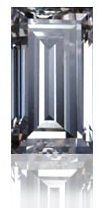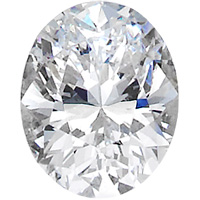Shapes and Cutting
Cut and cutting style work together to create a diamond´s brilliance. Cutting style is categorized into three basic types: step–cut, brilliant–cut and mixed–cut. The difference between these it the number of facets in each cut. A facet is an edge that is cut into a diamond. A 58–faceted diamond will have 58 edges or planes cut and polished into it.
Step–cut
This cut has rows of facets that reseble the steps of a staircase. They are usually four–sided and elongated. The Emerald and Baguette-cuts are examples of this.
Emerald
The emerald is unique because of the step cuts of its pavilion, and because of its large, open table. It produces a hall–of–mirrors effect, with an interplay of dark and light planes. The long lines and dramatic flashes of light give it an elegant appeal.

Emerald cuts vary from rectangle to nearly square. The classic emerald cut diamond has length to width ratio of about 1.50.
Inclusions are often easier to see in an emerald cut.
Baguette

Baguette diamonds are usually rectangular or oblong. They are very similar to the emerald cut, but they don’t have the mitred corners which make them octagonal instead of oblong. The cut will generally have 24 facets, with the parallel facets being arranged to look like a terrace.
Because it is possible to find smaller carat weights of baguette cut diamonds compared to others, the cost is generally lower.
Brilliant–cut
The most common brilliant cut is round, but can also be heart, oval, marquise, and pear. All brilliants have 58 facets and are admired for their fire and sparkle.
Round
Representing around 75% of all diamonds sold, the round cut is the most popular diamond shape. Due to mechanics ofits shape, it is generally superior to fancy diamond shapes at the proper light reflection, maximizing the potential brightness.

Basically all round diamonds are brilliant-cut, which means that they have 58 facets (or 57 when there is no culet). Round diamonds cost more per carat than fancy shapes because of the high demand, and low yield. Because more of the rough stone is lost in the cutting of it, the cost of each carat retained is higher. A typical round diamond may cost 23–25% more than a similar fancy shape.
Oval
Oval diamonds, like virtually all round cuts, are a modified brilliant–cut. Because they possess such similar fire and brilliance, the oval is ideal for a customer who likes the look of the round diamond, but wants to have something a bit more unique.

Ovals also have the advantage of an elongated shape, which creates the illusion of a greater size. It can also make the finger of the wearer look longer and slimmer, which is often desired.
Oval cut diamonds possess some degree of bow–tie, which varies from near invisible to severe. The visibility of this cannot be ascertained by reviewing a diamond certificate, it can only be upon visual inspection.
Heart
The heart shaped diamond a very unique, unmistakable symbol of love. It is very popular in solitaire pendants as well as rings. Symmetry is one of the most important characteristics, as it is important that the two sides are identical. The cleft, which is between the two lobes, should be dark and distinct. The wings, which are the sides that curve down, should have a very slightly rounded shape.

The heart shape is more difficult to see in smaller diamonds less than .50 carats, especially after being set in prongs.
Heart shape diamonds come in a range of silhouettes based on personal preference. They can be fat, and they can be narrow. For heats set in pendants, a slightly narrow cut is usually preferred, and for hearts set in a solitaire ring, a slightly wider cut is usually more desirable.
Marquise
Marquise diamonds are a modified brilliant-cut, in the shape of a football. Because they are long and narrow, they can also create the illusion of having a greater size. They have one of the largest crown surfaces of any diamond shape. Like the oval, its long shape can make the wearer’s finger look longer and slimmer.

Marquise diamonds possess some degree of bow–tie, which varies from near invisible to severe. The visibility of this cannot be ascertained by reviewing a diamond certificate, it can only be upon visual inspection.
Symmetry is very important with marquise cuts. Both end points should align with each other, and each side should form a near–mirror image. Any slight misalignment could result in an off-kilter look in the final setting
.
Pear
Pear shaped diamonds are a combination of round and marquise shape, with a tapered point on one end. Like marquise and oval cuts, they come in a variety of slim and wide cuts, making the finger of the wearer look longer and slimmer.

Symmetry is very important; the point should line up with the apex of the rounded end, and the shoulders and wings should form uniform, symmetrical curves with no straight edges. The rounded top should be like a semi–circle, not narrow or squat.
Pear shaped diamonds possess some degree of bow-tie, which varies from near invisible to severe. The visibility of this cannot be ascertained by reviewing a diamond certificate, it can only be upon visual inspection.
Mixed–cut
This has both step and brilliant cut facets. In the last 20 years, Mixed–cuts featuring step cutting on the crown and brilliant cutting on the pavilion have become increasingly popular. Mixed cuts combine the beauty of the step cut with the sparkle of the brilliant cut.

